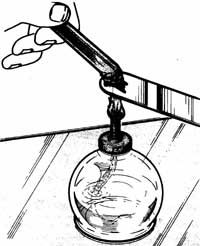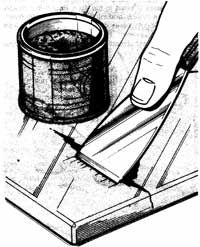How to Repair Furniture Cracks and Gouges
Cracks and gouges are a common problem on wood furniture, especially if the piece is old or is excessively used. Some basic restoration techniques can remove these problems as long as the damage hasn't gone beyond the surface.
Cracks and gouges should be filled so that they're level with the surface of the wood. For very small holes, like staple holes, wood-tone putty sticks can be used. If you can't match the wood, several colors can be mixed together. To use a putty stick, wipe it across the hole and smooth the surface with your finger. If you plan to finish or refinish the wood, let the putty dry for at least a week before proceeding further.
Advertisement
For larger holes, wood filler and water putty are the easiest fillers. These fillers can be used on bare or finished wood. Wood filler is available in several colors, and water putty can be tinted with oil or water stain.
However, wood filler and water putty patches are usually noticeable, and may look darker than the wood. For the best results, test the patch on an inconspicuous surface to make sure the color is right.
Wood Filler
To use wood filler, carefully clean the crack or gouge with the tip of a craft knife, then press the plastic firmly in with the tip of a craft knife or the edge of a putty knife. Wood filler shrinks slightly as it dries, so press it in tightly and leave it mounded slightly above the surface of the wood.
Wood filler dries fairly quickly, but let it set for at least two days. Then smooth the patch lightly with fine-grit sandpaper and buff the area with No. 0000 steel wool. If surrounding finish is involved, feather the edges so that the new patch blends in with it. Then, if necessary, stain the patch and buff it lightly with No. 0000 steel wool. Apply finish to match the rest of the surface, using an artists' brush and feathering the edges. Let the finish dry and then lightly buff it with No. 0000 steel wool; clean the area of any residue, and wax and polish the surface.
Water Putty
Water putty dries flint-hard, usually harder than the wood being patched. It's best used on bare wood. Water putty can be toned with oil and water stains, but you'll have to experiment to come up with a perfect match. To use water putty, mix the powder with water to the consistency of putty; then trowel it into the break with a putty knife, leaving the patch slightly high. Let the patch dry completely, and sand and steel-wool the area smooth and level with the surrounding surface. Finish the surface as above, or finish the entire piece of furniture.
Shellac Sticks
For the most professional patching job, use shellac sticks to fill cracks and gouges. Shellac sticks leave the least conspicuous patch and are very effective on finished wood that's in good condition. Shellac sticks are available in several wood-tone colors; use a stick that matches the finish as closely as possible. Practice on scrap wood before working on a piece of furniture.

Carefully clean the crack or gouge with the tip of a craft knife. Shellac sticks must be heated and melted to fill the crack. The best heat source for this is an alcohol lamp or a propane torch turned to a low setting. Do not use a match to soften the stick; the smoke from the match may discolor the shellac. Do not use a range burner; liquid shellac could damage either gas or electric ranges. Hold the stick over the blade of a palette knife or a putty knife to prevent it from dripping.
To use a shellac stick, hold it to the heat source above the knife, until it has softened to about the consistency of glazing compound or putty. Then quickly press the softened shellac into the crack and smooth it with the hot knife. Make sure the soft shellac fills the break completely; it hardens quickly, so you'll have to work fast. Leave the patch slightly high. Then, with the heated putty knife blade, trowel the shellac smooth.
Let the patch set for one to two hours. When the shellac is hard, plane or sand the surface smooth and level. The finish surrounding the break usually doesn't have to be retouched, but the surface can be coated with shellac, if desired. Apply the shellac finish. To make the shellac match a satin-gloss finish, rub the surface smooth with No. 0000 steel wool and linseed oil.
To fill very deep holes, use wood plastic or water putty to fill the hole almost level. Let the filler dry completely, and then fill the indentation with a shellac stick.
Wood Patch
If a hole or split is very large, don't overlook the possibility of filling it with a piece of wood cut and trimmed to fit perfectly. If the patching wood can be taken from the piece of furniture in a spot that won't show, the repair may be almost impossible to detect.
Fit the wood patch into the hole or split; use carpenters' glue to bond it to the surrounding wood. Leave the patch slightly high. When the glue is completely dry, sand the plug smoothly level with the surface of the surrounding wood. Then refinish the piece of furniture.
Even if the wooden surface is burned, it can still be repaired. Tips for removing mild scorches and for fixing more serious burns are outlined in the next section.
